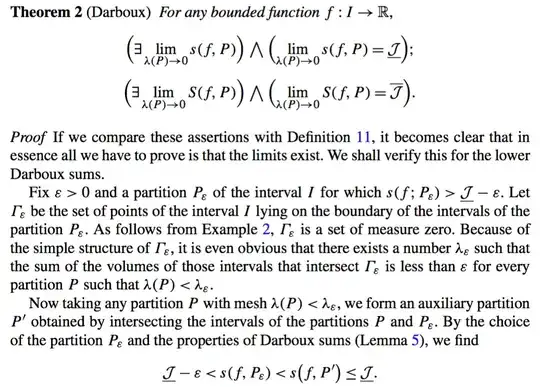The point is that for a partition $P$ with $\lambda(P)$ small enough, the lower Darboux sum $s(f,P)$ cannot be much smaller than $s(f,P_{\varepsilon})$. We can distinguish the partition intervals of $P$ according to whether they are completely contained in a partition interval of $P_{\varepsilon}$ or not. Clearly if $J_1 \subset J_2$, then
$$\inf\: \{ f(x) : x \in J_1\} \geqslant \inf\: \{ f(x) : x \in J_2\}\,,$$
so the part of the lower Darboux sum $s(f,P)$ corresponding to intervals contained in a $P_{\varepsilon}$-interval is not smaller than the corresponding part of $s(f,P_{\varepsilon})$. Thus "bad things" can only occur on intervals containing a partition point of $P_{\varepsilon}$. But we can control how bad the things that might happen there are. For every subset $S$ of $I$, we have $\inf\:\{ f(x) : x \in I\} \leqslant \inf\:\{ f(x) x \in S\} \leqslant \sup\:\{ f(x) : x \in I\}$, and therefore
\begin{align}
\lvert \inf\:\{ f(x) : x \in J\} - \inf\:\{ f(x) : x \in J'\}\rvert &\leqslant \sup\:\{ f(x) : x \in I\} - \inf\:\{ f(x) : x \in I\} \\
&\leqslant 2\,\underbrace{\sup\:\{\lvert f(x)\rvert : x \in I\}}_M\,.
\end{align}
So the worst that can happen is that the contribution to $s(f,P)$ of an interval of $P$ that contains a partition point of $P_{\varepsilon}$ is $2M$ times the length of the interval smaller than the contribution of this part of $I$ to $s(f,P_{\varepsilon})$. That adds up to
$$s(f,P) \geqslant s(f,P_{\varepsilon}) - 2M\sum_J \ell(J)\,,$$
where the sum is over those partition intervals of $P$ that contain a partition point of $P_{\varepsilon}$, and $\ell(J)$ is the length of the interval $J$.
Now there are only finitely many partition points of $P_{\varepsilon}$, say the number is $k$. And every partition point of $P_{\varepsilon}$ belongs to at most two closed partition intervals of $P$, so we find
$$s(f,P) \geqslant s(f,P_{\varepsilon}) - 2M\cdot 2k\cdot \lambda(P)\,.$$
And it's obvious that by requiring $\lambda(P)$ to be small enough, we can make the lower bound as close to $s(f,P_{\varepsilon})$ as we please. For example, with $\lambda_{\varepsilon} = \frac{\varepsilon}{4Mk}$ we get
$$s(f,P) > s(f,P_{\varepsilon}) - \varepsilon$$
for $\lambda(P) < \lambda_{\varepsilon}$, whence
$$\liminf_{\lambda(P) \to 0}\: s(f,P) \geqslant s(f,P_{\varepsilon}) - \varepsilon \geqslant \underline{\mathcal{J}} - 2\varepsilon\,.$$
